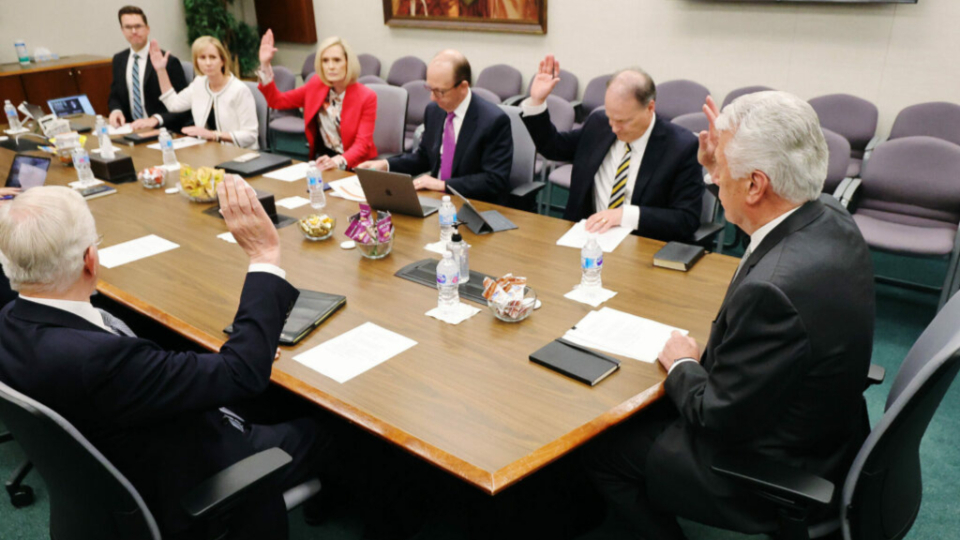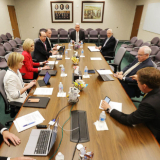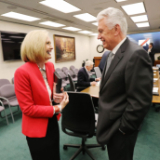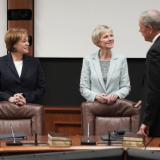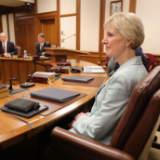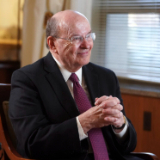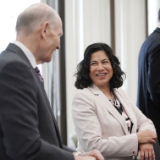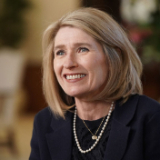| Five members of the Missionary Executive Council — clockwise from top, Sister Amy A. Wright; President Bonnie H. Cordon; Elder Marcus B. Nash; and Elders Dieter F. Uchtdorf and D. Todd Christofferson — raise their hands in support of an item during a Missionary Executive Council meeting in Salt Lake City, Utah, on Wednesday, May 26, 2021. Jordan Kesler, top left, and David N. Weidman, fourth from top left, are also present. Photo by Jeffrey D. Allred, courtesy of Church News. Copyright 2021 Deseret News Publishing Company. | 1 / 12 |
This story appears here courtesy of TheChurchNews.com. It is not for use by other media.
By Sydney Walker, Church News
Editor’s note: Part three in this four-part series on the essential role of councils in the Church features insight from members of the Quorum of the Twelve Apostles and general women leaders about the purpose and functions of three of the Church’s executive councils: the Missionary Executive Council, the Priesthood and Family Executive Council, and the Temple and Family History Executive Council. Read more in part one and part two and part four.
On Easter Sunday, April 3, 1836, Jesus Christ appeared to Joseph Smith and Oliver Cowdery in the Kirtland Temple and accepted the temple as His house.
Following this vision, three ancient prophets appeared to Joseph and Oliver, one at a time. Moses conferred the keys of the gathering of Israel, Elias conferred the keys “of the dispensation of the gospel of Abraham,” and Elijah conferred the keys of sealing.
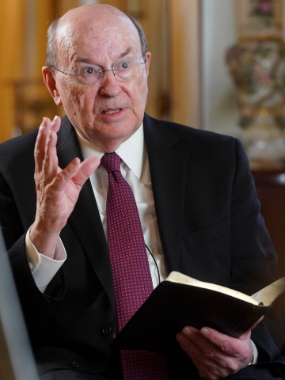
Church-Councils
Elder Quentin L. Cook of the Quorum of the Twelve Apostles is interviewed at the Relief Society Building in Salt Lake City, Utah, on Friday, March 19, 2021. Photo by Steve Griffin, courtesy of Church News.Copyright 2021 Deseret News Publishing CompanyToday, said Elder Quentin L. Cook of the Quorum of the Twelve Apostles, “The Church is organized with three executive councils that are based on those three keys that were restored.” These three councils serve under the direction of the First Presidency.
The keys of the gathering of Israel operate within the purview of the Missionary Executive Council. The keys of the dispensation of the gospel of Abraham — of fulfilling the Abrahamic covenant — function in the Priesthood and Family Executive Council. And the sealing keys are found in the Temple and Family History Executive Council.
Elder Dieter F. Uchtdorf of the Quorum of the Twelve Apostles said the purpose of these three councils is one work — God’s work “to bring to pass the immortality and eternal life of man” (Moses 1:39).
Elder Uchtdorf and Elder Cook — along with Elder David A. Bednar of the Quorum of the Twelve Apostles, Relief Society General President Jean B. Bingham, Young Women General President Bonnie H. Cordon and Primary General President Camille N. Johnson — recently spoke to the Church News about the essential role of councils in the Church, including the Missionary Executive Council, the Priesthood and Family Executive Council, and the Temple and Family History Executive Council.
Each of these three councils is chaired by a member of the Quorum of the Twelve Apostles and includes a member of the Presidency of the Seventy and the Presiding Bishopric, as well as two general women officers.
Missionary Executive Council
The Missionary Executive Council functions as “the extended arm of the Quorum of the Twelve Apostles for missionary work,” Elder Uchtdorf said. It focuses primarily on “proclaiming the gospel and making disciples” with the help of the current 52,000 full-time missionaries worldwide, he said.
Constantly seeking and reviewing feedback from local leaders and members around the world, the Missionary Executive Council meets weekly to discuss all aspects of missionary work — from calling new mission leaders, to creating new missions, to topics like missionaries and smartphones.In re
Priesthood and Family Executive Council
The purpose of the Priesthood and Family Executive Council is “to prepare people to meet God,” Elder Cook said. “It is to perfect the Saints.”
The Relief Society, Young Women, Young Men, Primary and Sunday School organizations serve in collaboration with and under the purview of the Priesthood and Family Executive Council, Elder Cook said.
Examples of topics discussed in this council include ministering, Come, Follow Me integrated curriculum, and the Children and Youth program.
“The council process refines things and perfects them,” Elder Cook explained. As these topics and others were discussed in the Priesthood and Family Executive Council and later with the Quorum of the Twelve Apostles and First Presidency, “revelation was received at various stages.”
President Bingham remembers sitting in the Priesthood and Family Executive Council when the question was asked, “How can the Church help families really be effective in learning the gospel?”
The council determined that the home is the ideal center of gospel learning. The next question was, “How can the Church support that in the home?” The solution became an integrated curriculum, she said.

Church-Councils
Relief Society General President Jean B. Bingham participates in a Leadership and Planning Committee meeting at the Church Administration Building in Salt Lake City, Utah, on Tuesday, May 11, 2021. Photo by Jeffrey D. Allred, courtesy of Church News.Copyright 2021 Deseret News Publishing Company.The shift from home and visiting teaching to ministering in 2018 — the focus on principles and added flexibility — helped lay the groundwork for Come, Follow Me for individuals and families.
“We took what we learned from ministering and applied it to the family,” President Bingham said. Then, as families worked to remodel their homes into a center of gospel learning through Come, Follow Me, they were prepared for the Children and Youth program.
“Parents were understanding more clearly that it is their responsibility to teach their children the gospel of Jesus Christ to help them to develop, to lead them to the Savior,” she said.
These initiatives and others are part of what Elder Cook describes as an “interlocking pattern of strength” — strength that came through revelation received counseling in councils. Through inspired leaders, the Savior Jesus Christ prepared His Church both temporally and spiritually for changing and challenging times, he said.
Looking back, President Bingham said, “You can see that the Lord prepared all of us for the time of the pandemic, when we couldn’t get together in our churches, when we had to support one another in families and at home.”
Temple and Family History Executive Council
“Everything pertaining to the temples — the covenants, the ordinances, the operations and family history work — is the responsibility of the Temple and Family History Executive Council,” Elder Bednar said.
As more temples are constructed around the world, “We are learning that some of the processes and procedures used in large temples are not as effective in the smaller temples,” he explained. “And the pandemic has provided an opportunity to consider every aspect of how temples are operated.”
“Without altering the covenants, the ordinances and the sacred matters that occur in the temple, we are striving to enhance the patron experience for members of the Church around the world,” he said.
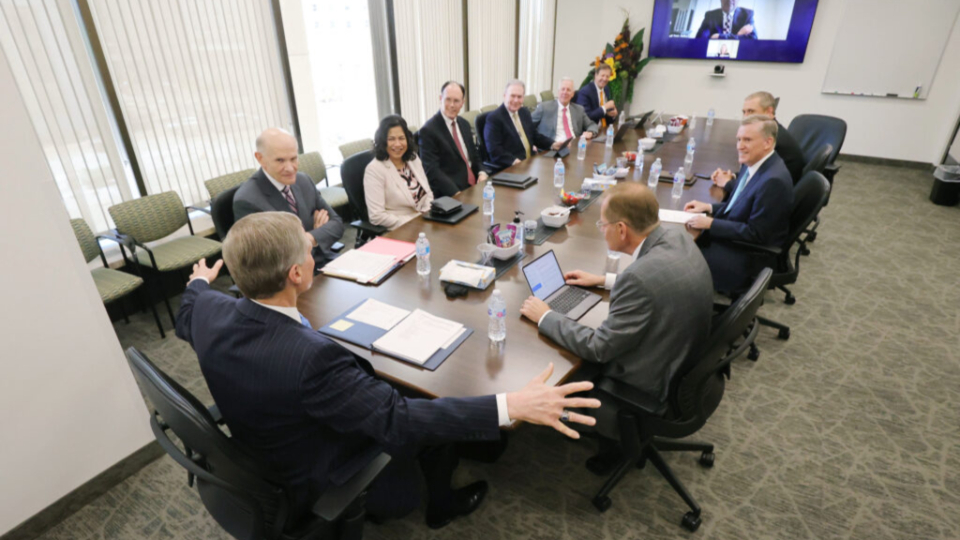
Church-Councils
Elder David A. Bednar of the Quorum of the Twelve Apostles leads a Temple and Family History Executive Council meeting at the Church Office Building in Salt Lake City, Utah, on Wednesday, June 2, 2021. Primary General President Camille N. Johnson was excused from the meeting. Photo by Jeffrey D. Allred, courtesy of Church News.Copyright 2021 Deseret News Publishing Company.Those who have attended the temple since the pandemic have likely noticed operational changes there. “Those adjustments are a result of issues that were identified, brought forward to the presiding councils for review, consideration and counsel, and ultimately approved to be incorporated into the operations of the temples,” Elder Bednar said.
Shortly after she was sustained during the April 2021 general conference, President Johnson received an assignment to serve on the Temple and Family History Executive Council.
“In a great act of kindness and benevolence, Elder Bednar invited me to his office with the two General Authority Seventies who are responsible for family history and temples, and gave me an overview of what our executive council was going to address,” the newly called Primary general president said.
“What a blessing that was so that I went into that first meeting having some confidence about the subject matter that we were going to cover,” she added.
As the newest member of the council, “I don’t have a lot of context to bring to it, but I have my perspective as a Latter-day Saint woman,” President Johnson said. “And that’s what they’re seeking. I really appreciate that. I felt included right from the beginning.”
President Johnson said she was also told that every Temple and Family History Executive Council meeting is “a revelatory process,” and that if she came prepared, she would “see something with new eyes.”

Church-Councils
Sister Camille N. Johnson, Primary general president for The Church of Jesus Christ of Latter-day Saints, is interviewed in the Relief Society Building in Salt Lake City, Utah, on Wednesday, May 12, 2021. Photo by Jeffrey D. Allred, courtesy of Church News.Copyright 2021 Deseret News Publishing Company.“And that’s been the case,” she added. In just a few weeks, she said she has gained a broader vision of the importance of temple and family history work.
“Our focus in Temple and Family History — and really everything we do — is how are we all going to get back to our heavenly home?” she said.
“It’s what we’re doing in our ward, our stake and in our family councils, is inviting the Savior into the process and letting Him help us,” President Johnson added. “He’s the reason we can return to our heavenly home because of His Atonement.”
More About the Four-Part Inside Church Headquarters Series
Part one — President Dallin H. Oaks and President Henry B. Eyring discuss what they have learned about revelation in councils and from President Russell M. Nelson’s leadership.
Part two — President M. Russell Ballard and other members of the Quorum of the Twelve Apostles explain why the Church is governed by councils and give examples about how “inviting, receiving and recognizing revelation” can happen in every council.
Part three — Members of the Quorum of the Twelve Apostles and general women leaders give insight into the purpose and functions of three of the Church’s executive councils: the Missionary Executive Council, the Priesthood and Family Executive Council, and the Temple and Family History Executive Council.
Part four — Church leaders highlight principles of counseling practiced at the general level that can help stake, ward and family councils be more effective.
Copyright 2021 Deseret News Publishing Company
